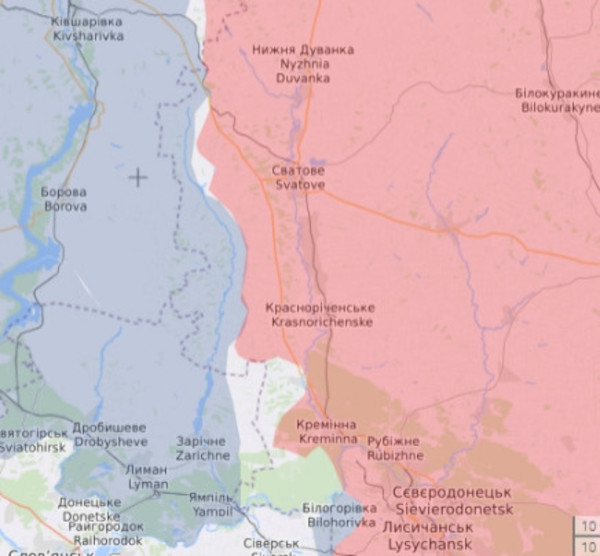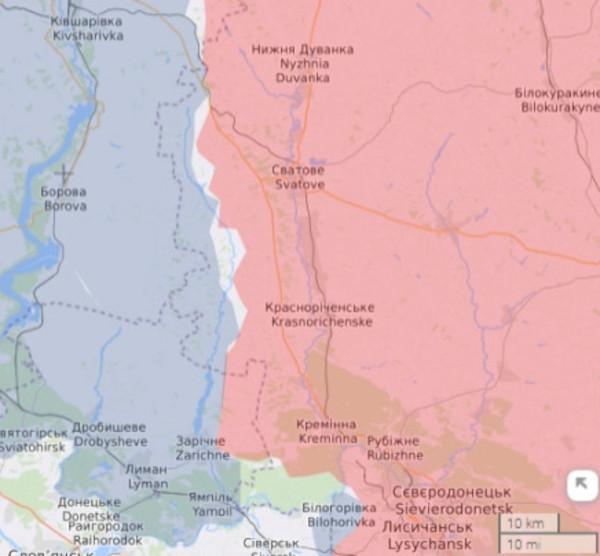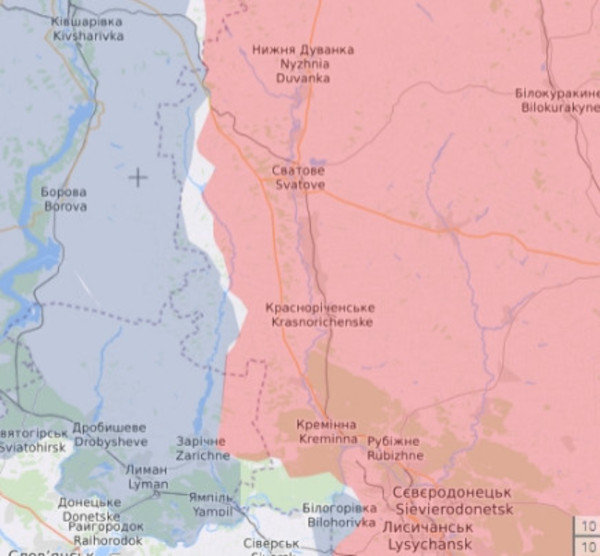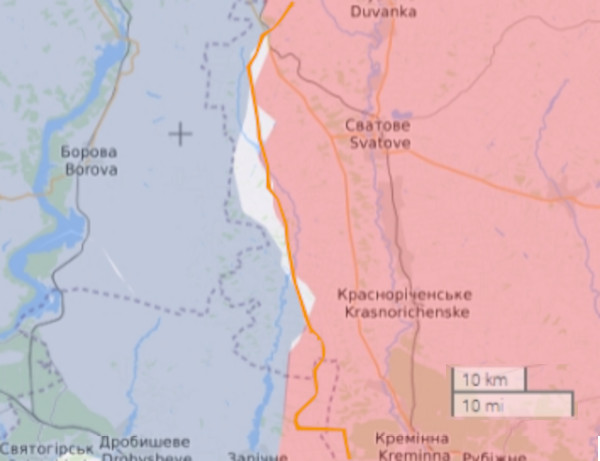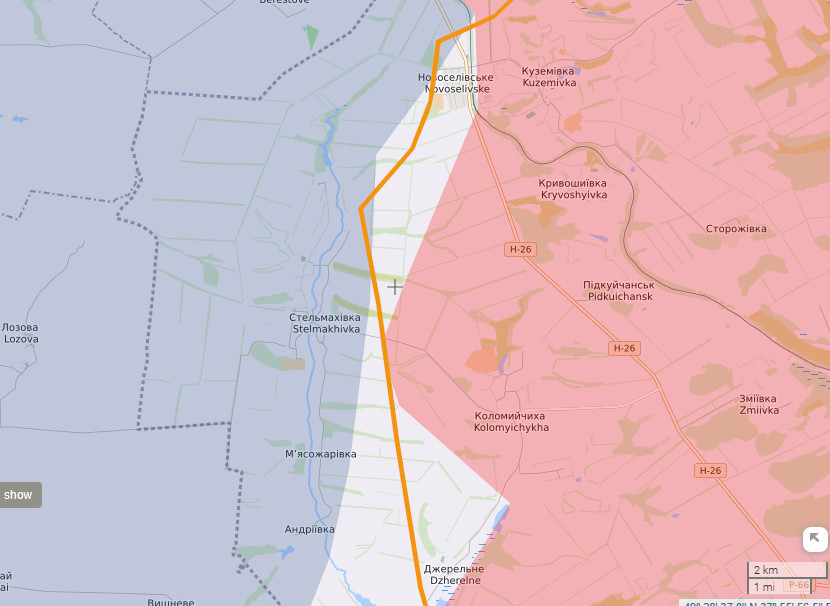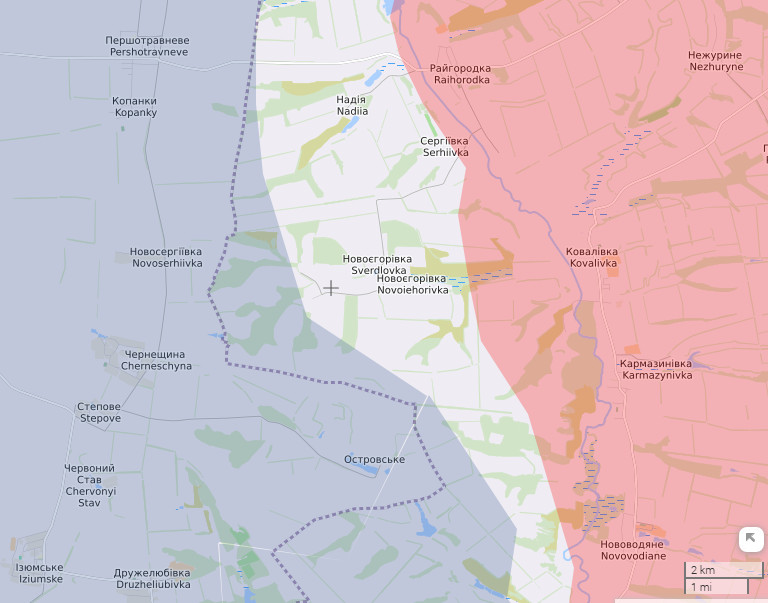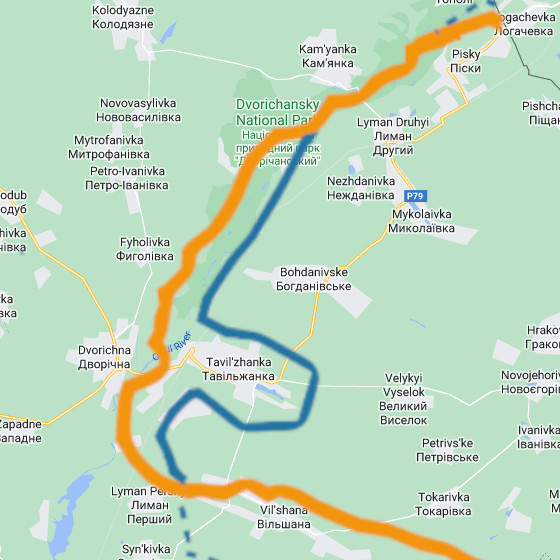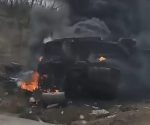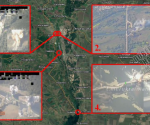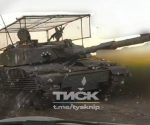The Kupyansk and Krasny Liman directions, July and August 2023
What better tool is there for a discreetly totalitarian government than social media where the ignorance that is all pervasive (by design) can be organised to create the impression of a zeitgeist in support of the political agenda.
Take the warfare in the Ukraine, for instance. One will see time again some idiotic boasting that, while Ukrainian forces can capture territory from the enemy, the Russian ones cannot. Naturally, it requires a reader of this stuff to ignore the empirical evidence (if there is access to it, that is) which would disprove it – to doublethink – or, more often, be as stupid as it is possible to be. But instead of becoming bogged down in methodology for the control grid, it is much easier to summarise the state of affairs by saying that social media is steeped in the culture of Western military doctrine, whether it realises it or not.
There is tendency to judge according to how Western tacticians have deemed war should be fought, commonly appreciated through news and cinematic film media as it portrays the execution of this standard. Additionally, there has been the construction specific to this particular conflict of a benchmark about how the exemplar model is achieved, and this is used as a practical gauge. The reference, of course, is to the Ukrainian so-called counteroffensive to recapture a portion of the Kharkov region. With this, even the most casual of observers could see war being won in the way that, as it has been implied to them by the means abovementioned, it should be. With the devastating Russian blows dealt at the opening of the conflict entirely forgotten, this instance of the Ukrainians executing manoeuvre warfare (about which there is more later) and capturing large pieces of land is held up as being indicative of the Ukrainian capability and ability to be ultimate victors.
On the contrary, in stark contrast to the mercurial Ukrainians, the Russians are portrayed as plodders, who take interminable amounts of time to gain any territory, if they can at all. And it is by this measure that one is supposed to adjudge how they are bound to lose.
Of course, the scale of the perversity is of a sort that is unusual even for a scheme for managing perception as devised by Western (with London at the root) military intelligence psychological warfarists.
For it is the truth of the matter that, in their Special Military Operation, the Russians have made Western military doctrine somewhat if not totally redundant so that Ukrainian, or rather UK/US victory cannot be achievable by the ideals that are supposed to make it inevitable. Furthermore, what happened in Kharkov was not a demonstration of a relationship between tactics and assured winning, it was instead an example of how the Russians exploited what they must have been able to predict the UK/US/Ukraine would do in order to partially destroy the second iteration of the Ukrainian armed forces. There’s no way that one can have an understanding of how Russia has blunted Western military potency and not appreciate that the Russians baited the UK/US/Ukraine into a trap in Kharkov. Moreover, when the recapture of Kharkovian territory was seen as the inevitable outcome of dogma by UK/US planners, they made the fateful decision that the job of expelling the Russians to pre-2022 demarcations could be finished off in 2023. They had been fooled.
What we are seeing now in Zaporozhye, South Donetsk and Donetsk is the Russians removing any remaining illusion about the relationship between Western military doctrine and inevitable victory. The Russians are quite simply making execution of the tactics fail. The “tactical depth” – what we might call a general concept to do with staging an aggressive defence – that the Russians are using, as they destroy the third iteration of the Ukrainian armed forces, has nothing to do with giving-over a range of territory through which the attacker can probe for weakness to be exploited, trading this potential off against the risk of being attrited. It is achieved by superior stand-off fire power. “This week” wrote Forbes’ David Axe on 22nd August, “the 82nd [brigade (see here)] wrote off at least two of its 20 or so M1132 Engineer Squad Vehicles—mineclearing versions of its 18-ton, eight-wheel Stryker infantry-carriers.”
The piece continued:
It’s unclear what struck the M1132s and whether the crews survived. It’s possible the vehicle were victims of the same mines their crews were trying to clear. It’s also possible they got caught in artillery barrages or were hunted down by drones. In any event, the 82nd already has lost 10 percent of its mineclearing Strykers.
The emphasis has been added to indicate how a reluctant admission has been made. Indeed, it has also been explained in a previous FBEL article (see link above) how the minefields that the Ukrainians must overcome could also be counted as Russian stand-off capability.
What is supremely significant in all this is that, in the Western doctrine, the Russian’s stand-off fire is the “stone which the builders rejected” – and yet, as the phrase continues, “the same is become the head of the corner”.
Before there is further explanation and exploration of the defeat of the UK/US in what is the most fundamental way, there’s going to be a discussion of evidence that demonstrates the reality of the Ukrainian battlefield.
Consider the reports from the Russian MoD listed at the bottom of the page. Groupings 1 and 2 are about events in the Donetsk direction in December 2022 and January 2023 prior to the liberation of Soledar on Jnauary 12th. The reports of the first groupings are earlier in this time frame, and one can discern a pattern that is repeated in the third grouping, which contains recent reports about the Kupyansk direction. It can be seen that after an unanswered uprooting of Ukrainian positions, or the setting up of a more advantageous situation against them, there are several days of retaliation against the Russians in the form of fended-off counter forays.
Then, in the second grouping, one can see that the fighting has taken on a new complexion, where it consists of several days of undisrupted Russian attacks. This shows us what to expect in Kupyansk.
For we know from hindsight that at the time of the reports from late December, Russia was conducting an offensive in which territorial gain was the objective. While they were able, the Ukrainians had been responding according to the West’s manoeuvre warfare doctrine where, in defence, there is an onus on counterattack (over positional defence) to achieve the same sort of outcome as an attacker would hope to achieve on the offensive by the same doctrine in terms of disrupting the enemy’s ability to fight. Again, there’s a bit more to be said about this, but firstly the reader should understand that the Russian MoD’s reports that are listed here suggest that, at some point in December, the Ukrainians ceased to be able to conduct their defensive operations in the Donetsk direction in relation to Soledar and other settlements around Artyomovsk captured at about the same time. It appears as if the Russians simply wore them down to that state.
So, if the Russians are looking to close to the banks of the Oskil through the eastern part of Kupyansk – which is what the author thinks is the intention – we should suppose by their proven capability that they will do it. The Ukrainians will simply have their defensive wherewithal ground down. Indeed, there is a story doing the rounds – carried by no less than The New York Times – that the Ukrainian general Syrsky has felt the need to divert reserves to the Kupyansk direction against American advice. While there is no need to believe that the story or any of its elements are true, it is reasonable to believe that the Ukrainian defence will inevitably collapse.
The delicious irony is that the organisational breakdown that the Russians cause in what might be called their active positional defence – which has an element of local elasticity (involving a forward mobile element) but garners its fire aimed at the point of Ukrainian assault from a line of artillery – is considered the less favourable method by Western tacticians. Theirs, of course, is manoeuvre warfare.
Organisational breakdown, by the way, and to put it simply as possible, means a state of affairs where a fighting force is made to be incapable of fighting, and a watershed in a level of disruption of the enemy has been made to occur. With manoeuvre warfare this state is meant to be brought about by being mobile, conducting aggressive reconnaissance, and finding and attacking the enemy at weak points: by avoiding the enemy’s strength, and introducing chaos to bring about a state of psychological affairs where fighting becomes the enemy’s less preferable option.
Of course, that this is the UK/US/Ukraine’s way of warfare has not been missed at this site. There have been many articles describing it without getting into the vocabulary.
It should be noted, in actual fact, that archetypal manoeuvre warfare is supposed to involve having air supremacy. The Ukrainians have never had this, of course, but this shouldn’t be the only reason why their planners must be revaluating its necessity, its meaning, and be making adjustments in the light of the ascendency of drone warfare, and Russian bias towards air defence and artillery, and also their use of ranged guided bombs and air defence beating missiles. Air supremacy in Western manoeuvre warfare appears to be about tactical support – hitting the enemy from the air to improve the shock value of the attack by land. The Russians, in contrast, have blanket surface-to-air, or surface-to-surface coverage, in defence or attack, that disallows this air supremacy.
This is not the only way that the Russians have punctured the effectiveness of the UK/US/Ukraine’s way of warfare. The Russians are able to frustrate the requirement in manoeuvre warfare for as little “protection” – as the doctrinal language has it – as possible. Protection from the enemy’s strengths is generally brought about by using speed or using cover – theoretically, there is no need for any other means. In practice, however, protection via a holding force (for instance, one that digs itself in against the face of an enemy) is required against an element of the enemy that can’t be dislocated by manoeuvre – but we don’t need to get very far into what that means. If your strength resides in stand-off weaponry in combination with aerial reconnaissance, as the Russians’ does, this provides a virtual expansion of your defensive tactical depth. What is meant by this is that a state of affairs has been produced whereby there is an increase in opportunity to find and block the enemy in the act of manoeuvre long before it reaches the weak point that it wants to attack. Moreover, the strongest element of your forces cannot be held by the enemy because it is far behind the lines.
On the other hand, the Russians, knowing that protection for the Ukrainians conducting an offensive must largely come in attacking through cover, can therefore deploy a concentrated forward holding force to contest that space. This is why the Ukrainians, it seems to the author, are currently reduced in their supposed broad counteroffensive to trying to fight through the two settlements of Rabotino and Verbovoye in the Zaporozhye direction. In effect, this trying to get through the eye of a needle is what the Russians have reduced Ukrainian manoeuvre warfare to. Incidentally, any supposed success by Ukraine in capturing Rabotino doesn’t begin to solve the problem that would follow of where next to go and which reserve brigade would go to get there, nor what shape they could hope to survive in during the going. English language propaganda about the Ukrainians having success here is indescribably, ludicrously optimistic.
Returning to the main topic of the piece, however, which is Russian offensive action being undertaken in the Kupyansk and Krasny Liman directions, and further to being introduced to the signs of it in the former through what the Russian MoD has been saying in its briefings, the reader is asked to consider the maps to be found at the very foot of the page.
Continuing to deal with the situation around Kupyansk city, between them, Figs. 9 and 10 show how the Ukrainians have conceded that the Russians are nearer to Sinkovka that at any time during the Russian progress that has occurred in this theatre since the end of 2022.
Moving to the situation further south, the difference between Figs. 1 and 2 shows how the Ukrainians have acknowledged being thrown back between Kremennaya and Svatovo during the course of June and July – this at the same time that they were supposed to be bringing the Russians to organisational breakdown in Zaporozhye and South Donetsk, and being on the way to Melitopol and Mariupol. This site reported as early as February 2023 that the Russians were on the move in this part of the front.
Fig. 3 Shows how the Ukrainians acknowledged at the end of July that the Russians had crossed the Zherebets River, which is at the part of the front line that falls in the middle between “Krasnorichenske” and “Svatove” as these places are marked on the map. Fig. 4 is a map that shows how the Russians were also possibly at the Zherebets north of Svatovo. Various reports suggested that the orange line of Russian control, gleaned from Russian MoD briefing maps, was indeed in the place as drawn.
Fig. 5 shows this in greater detail, and how the Russians were close to crossing the river via Stelmakhovka in its more northern environs. It also seems to confirm social media reports of mid-July of Novoselovskoye having being liberated. Fig. 6 is also a map that shows greater detail, this time of the bridgehead across the Zherebets (previously mentioned in connection with Fig. 3).
Fig. 6 is meant to provide food for thought. It shows how Russian activity is joined up along the north of the Krasny Liman theatre, and in the Kupyansk one. The Russian activity next to and over the Zherebets in July is aligned with the two major crossings of the Oskil river south of Kupyansk itself. A pending danger for the Ukrainians in relation to how the Russians finally act to close off the eastern bank of the Oskil River from the western one – which is something that suggests itself as being an obvious thing to want to do – has been written about often at this site. Stelmakhovka is only 10 miles from the crossing at “Senkove”. Novoyegorovka, which is adjacent to the Zherebets bridgehead (if the Russians don’t actually control it) is 17 miles from its associated Oskil river crossing. No predictions are offered about what the Russians are going to do (and, maybe, more time is required for analysis), but the situation is clearly not a happy one for the Ukrainians. The Russians are bearing down on them in this part of the world, threatening to cause a large scale defeat, or at the very least cause the Ukrainians to surrender some very valuable territory in terms of its propaganda worth – and there cannot be any denial of it.
Grouping 1; reports from the Donetsk direction, mid-December, 2022:
10th:
In Donetsk direction, Russian units continued their offensive, knocking the enemy out of fortified strongpoints.
More than 50 Ukrainian servicemen, two infantry fighting vehicles, one armoured personnel carrier and three pick-up trucks have been eliminated.
11th:
In Donetsk direction, Russian troops have carried out offensive, repelling the AFU counterattacks in some directions. Up to 40 Ukrainian servicemen, two armoured fighting vehicles and three pick-up trucks have been eliminated.
12th:
In Donetsk direction, the Russian troops continued the offensive.
As a result of pre-emptive fire, an attempt by an enemy company of the 59th Motorised Infantry Brigade of the Ukrainian Armed Forces was foiled to counterattack Russian positions in the direction of Peski (Donetsk People’s Republic).
13th:
In Donetsk direction, while continuing the offensive, Russian troops repulsed three enemy counterattacks during the day. As a result of the fire damage, more than 30Ukrainian personnel, four armoured combat vehicles, and three pickup trucks were annihilated.
Grouping 2; reports from the Donetsk direction, December 2022 and into 2023. Note that the Russians declared that Soledar was liberated on the evening of 12th January, 2023. It was “of great importance for continuing successful offensive operations in Donetsk direction”.
29th:
In Donetsk direction, Russian forces continued their offensive operations that have resulted in taking new advantageous lines and positions.
The enemy has lost over 80 personnel, four infantry fighting vehicles, three armoured fighting vehicles, and six motor vehicles.
30th:
In Donetsk direction, successful offensive operation of Russian forces has resulted in the neutralisation of the units from 25th Airborne Brigade of the AFU near Krasnaya Gora, and 60th Mechanised Brigade of the AFU near Kleshcheyevka (Donetsk People’s Republic).
The enemy has lost up to 50 Ukrainian personnel, three armoured personnel carriers, and four pickups in the abovementioned direction.
31st:
In Donetsk direction, Russian forces continued their offensive operations by launching attacks, involving Operational-Tactical and Army aviation, artillery, and heavy flamethrower systems, at AFU manpower and hardware concentration areas.
Over 80 Ukrainian personnel, two armoured personnel carriers, four armoured motor vehicles, and three pickups have been eliminated.
1st:
In Donetsk direction, Russian troops continue their offensive.
Fire attacks and intensive action of Russian units have resulted in the elimination of over 110 Ukrainian personnel, two infantry fighting vehicles, five armoured fighting vehicles, and seven motor vehicles.
Grouping 3; the most recent reports from the Kupyansk direction:
23rd:
In the Kupyansk direction, the assault detachments of the Zapad Group of Forces carried out offensive actions in the assigned areas of responsibility and improved the tactical situation.
With the support of aviation, artillery fire, and heavy flamethrowers, four attacks by assault groups of the 67th, Mechanised, 68th Jaeger, 25th Airborne, and 95th Air Assault brigades of the Ukrainian Armed Forces were repelled close to Sinkovka (Kharkov region), Novoyegorovka, and Novosyolovskoye (Lugansk People’s Republic).
The enemy’s losses in this direction during the day amounted to up to 170 Ukrainian troops, one tank, five armoured fighting vehicles, three pick-up trucks, one U.S.-made M777 artillery system, as well as one D-20 howitzer.
24th:
In Kupyansk direction, assault detachments of the Zapad Group of Forces continued successful offensive operations in the assigned areas of responsibility.
As a result of courageous actions by units, Army Aviation and artillery, five enemy attacks have been repelled close to Novosyolovskoye, Novoegorovka (Lugansk People’s Republic) and Sinkovka (Kharkov region).
The enemy losses were up to 50 Ukrainian servicemen, two infantry fighting vehicles, three pickup trucks, and three U.S.-manufactured M777 artillery systems.
25th:
In Kupyansk direction, units of the Zapad Group of Forces, supported by aviation and artillery, have repelled three attacks by 47th mechanised and 68th jaeger brigades of the AFU close to Sinkovka (Kharkov region) and Sergeevka (Lugansk People’s Republic).
The enemy losses were up to 50 Ukrainian servicemen, two tanks, three infantry fighting vehicles, two pickup trucks, and one D-20 howitzer.
26th:
In Kupyansk direction, during active operations, the units of the Zapad Group of Forces, supported by aviation and artillery, have improved the situation along the front line.
Five attacks by assault detachments of 115th mechanised, 25th airborne and 68th jeager brigades of the AFU have been repelled close to Sinkovka (Kharkov region), Novosyolovskoye, Raigorodka, and Novoegorovka (Lugansk people’s republic).
The enemy losses were up to 50 Ukrainian servicemen, four armoured fighting vehicles, two motor vehicles, one Polish-manufactured Krab self-propelled artillery system, and two D-20 howitzers.
27th:
In Kupyansk direction, the Zapad Group of Forces, supported by aviation, artillery fire, and heavy flamethrowers, repelled 11 attacks by assault detachments of the 43rd, 44th, 115th mechanised and 68th Jaeger brigades of the Ukrainian Armed Forces during the day in the areas of Sinkovka (Kharkov region), and Novosyolovskoye and Novoegorovka (Lugansk People’s Republic).
The enemy’s losses in Kupyansk direction amounted to up to 120 Ukrainian servicemen killed and wounded, one tank, three armoured fighting vehicles, three motor vehicles, as well as a U.S.-made M777 artillery system.
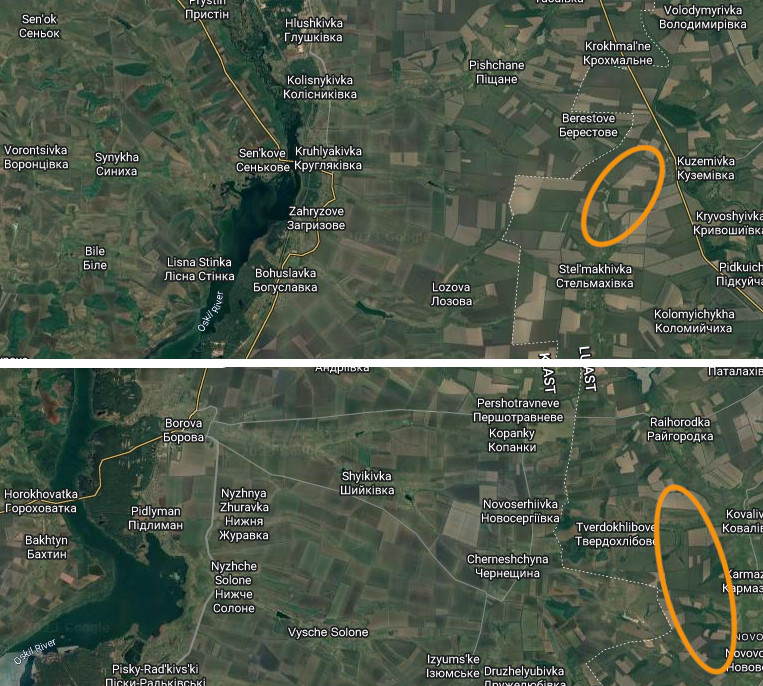
Fig. 7: The areas of Russian offensive, as shown in Figs. 5 & 6, in relation to the Oskil river crossings.
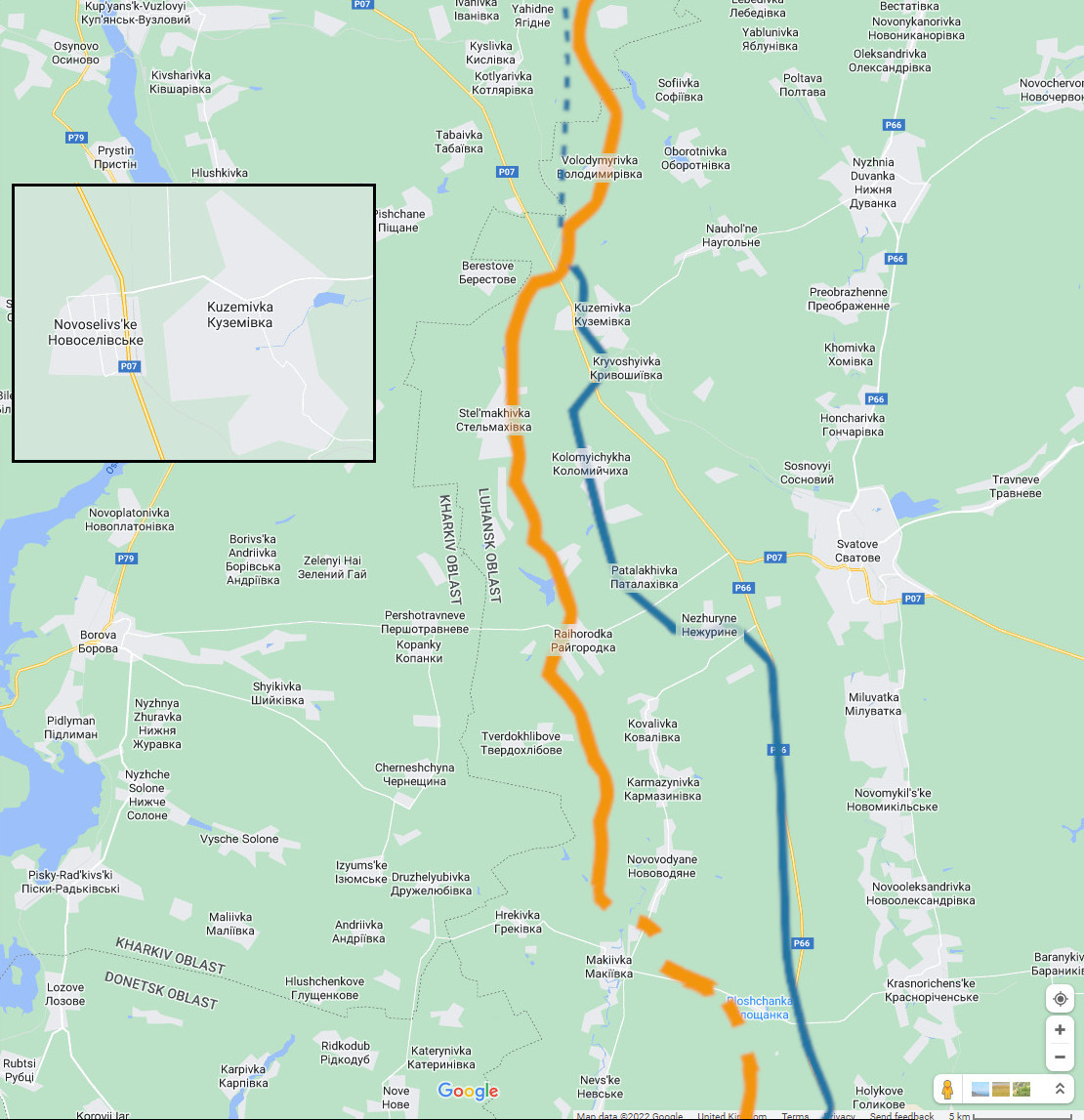
Fig. 8: A map featured in The Kupyansk And Krasny Liman Directions from December 2022. In the very least it serves to remind that, so far in the SMO at least, while the the anti-Russian axis sees things very differently, for the Russians the shape of the front line is only a means to an end. It suggests how the Russians were still to fall back in the centre of the length of front shown before the arrival at the state of affairs written of in The End Of The “Battle Of The ‘Svatove–Kreminna’ Line”.
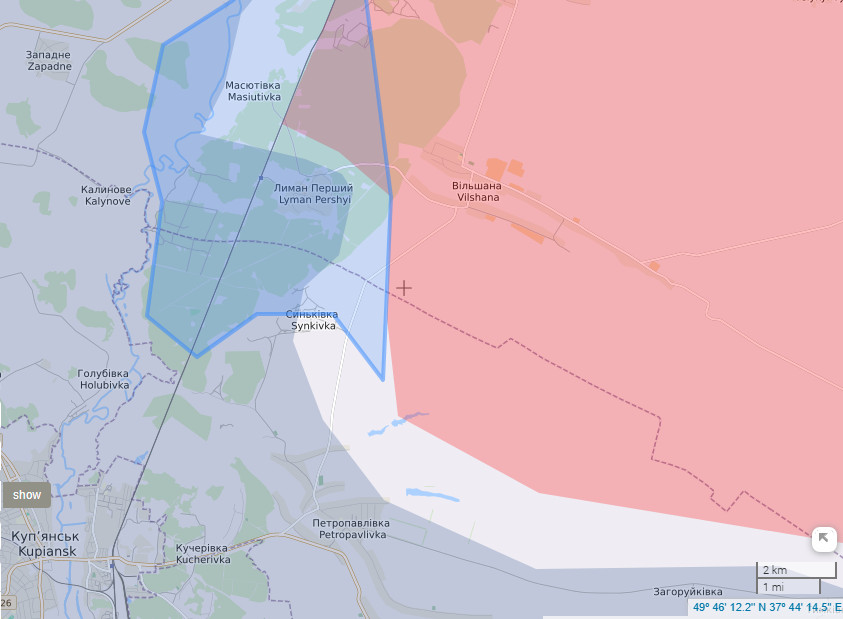
Fig. 10. This is the pro-Ukrainian Liveuamap’s latest reckoning of Russian control north-east of, and moving toward Kupyansk – shaded red, or course. The shaded area within the blue line is the author’s rough estimation, built from various sources of information, at the real extent of Russian control to the north of said city. He wouldn’t like to guess how close the Russians really are to Petropavlovka.




